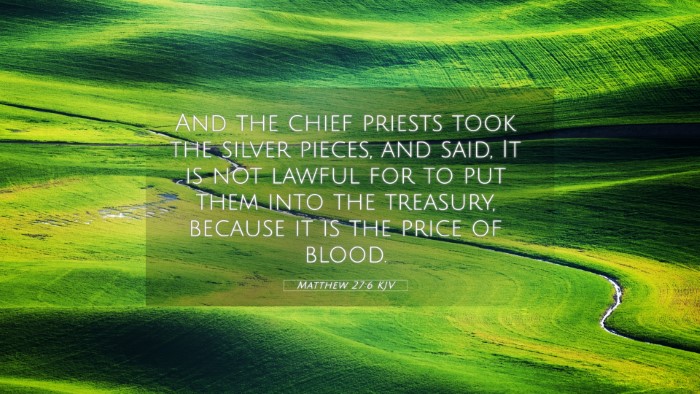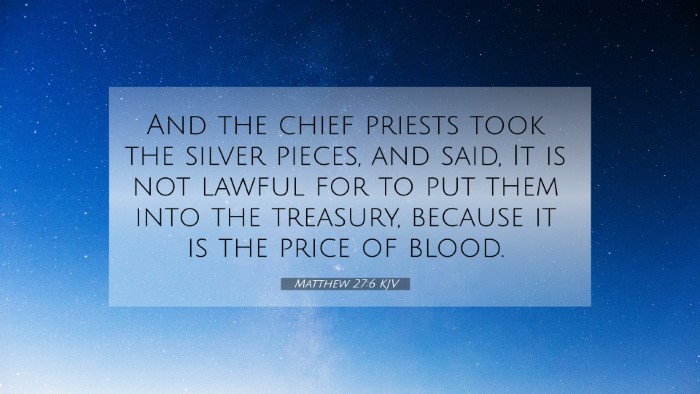Understanding Matthew 27:6
Matthew 27:6 states, "And the chief priests took the silver pieces and said, 'It is not lawful to put them into the treasury, because they are the price of blood.'" This verse encapsulates several profound themes related to morality, guilt, and the fulfillment of prophecy, providing a rich ground for analysis and interpretation.
Contextual Background
This passage appears in the latter portion of the Gospel of Matthew, a narrative that details the events leading to the crucifixion of Jesus Christ. It follows the betrayal of Jesus by Judas Iscariot, who sold his master for thirty pieces of silver—a poignant symbol of betrayal and moral corruption.
Verse Meaning and Analysis
The actions of the chief priests reveal the complexities of human ethics, particularly in a religious context. The refusal to put the money into the treasury is significant as it highlights the priests' awareness of the immoral nature of the money they received. This reflects a critical theme found throughout Scripture: the conflict between human laws and divine morality.
Insights from Matthew Henry
Henry emphasizes the symbolism of the "price of blood," indicating that the betrayal of Jesus introduces a grim reality where monetary gain is tied to moral failure. The priests understood the bloodshed they were complicit in, which led to a disdain for their ill-gotten gains.
Insights from Albert Barnes
Insights from Adam Clarke
Clarke notes that the chief priests’ reasoning is steeped in Jewish law and tradition, which dictated that such money, procured through a heinous act, could not be used for sacred purposes. This illustrates how guilt can influence the interpretation of divine commandments.
Bible Verse Cross-References
- Exodus 21:32 - Discusses the value of a slave, relating to Judas' betrayal through its financial implications.
- Zechariah 11:12-13 - Prophetic references about the thirty pieces of silver, further enhancing the connection to Judas' actions.
- Matthew 26:15 - Details the agreement Judas made with the chief priests, providing background for the motivations behind the betrayal.
- Acts 1:18-19 - Describes Judas’ fate, highlighting the consequences of his betrayal.
- Jeremiah 32:6-9 - A reference to the themes of redemption, reflecting on the idea of land and property, contrasting with the worthless price paid for Jesus’ betrayal.
- Psalm 69:4 - A lamentation of betrayal and injustice, paralleling Christ's suffering and betrayal.
- 1 Timothy 6:10 - Discusses the love of money as the root of all evil, connecting with the motivations behind the transactional nature of Judas' betrayal.
Theme Exploration through Cross-Referencing
Matthew 27:6, when examined alongside these references, provides a thematic connection exploring concepts of betrayal, guilt, and redemption. The verse serves as a convergence point for understanding the repercussions of moral failure in the context of divine prophecy.
Tools for Bible Cross-Referencing
Utilizing a Bible concordance can greatly enhance one's ability to uncover these connections between verses. Tools such as a bible cross-reference guide and bible reference resources offer various methods for exploring scriptural parallels and themes in-depth.
Conclusion
In conclusion, the verse Matthew 27:6 serves as a potent reminder of the complexities surrounding human morality and divine law. Its implications extend far beyond its immediate context, inviting believers to engage in a thorough exploration of both the intrinsic and extrinsic links between scripture passages.
By studying the Bible verses that relate to each other and employing methods for cross-referencing Biblical texts, we can gain a more profound understanding of both the text's meaning and its relevance in the continuum of faith and ethics.







